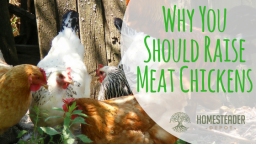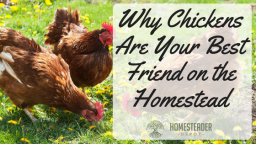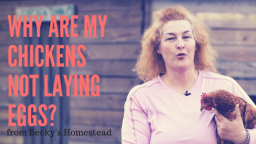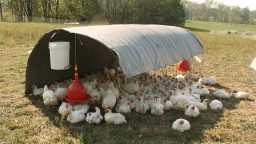Chickens are some of the best and easiest homestead animals you can raise, but their feed bill can get kind of pricey, especially if you have a big flock! Not to mention, what chickens really want to eat, and what gives their yokes that beautiful, rich yellow color is lots of fresh produce. Like us, chickens benefit the most from a diet full of a wide variety of plants, fat, and protein.
If you can let your chickens scratch around in a pasture, this is ideal. They love to hunt for bugs (most people don’t realize that chickens are actually predators!), and they love eating grass and shoots and whatever they can get their claws on.
There are also several great crops you can grow for your chickens, that you can either plant in the area they frequent, or harvest and feed to them, to reduce your chicken feed bill and get them that optimum nutrition they need and love.
Here are a few of the best plants to grow for feeding to chickens:
Sunflower
Sunflower is pretty easy to grow, really fun to watch, especially if you’ve got small children, and, when it’s done, you can toss the big flowers in your chicken pen and let your chickens go nuts on it. They’ll love the protein and fat-rich seeds, and the sport of pecking them out!
Peas
Peas make a great ground cover crop, and if you’ve got the space for a lot, they’re a wonderful supplement to any chicken diet. They’ll most likely enjoy nibbling on the whole plant, not just the peas themselves.
Clover
Clover is another great cover crop, that’s very easy to grow and wonderful for chickens to eat. You can plant it as you would any other cover crop, and simply pull small patches up to feed to your chickens. It will regrow pretty quickly, making it a reliable source of fresh greens for your ladies. It is also ideal for inside their coops or in an area you let them scratch.
Dandelion
You most likely won’t have to grow dandelion, you probably already have it growing in your yard! Dandelion is a wonderful all-purpose herb, you can eat every part of the flower, leaves, and roots, and also make very beneficial medicines out of it. On top of that, chickens love to eat it! If you have a field with a lot of dandelion growing in it, let your chickens scratch around there, or, buy some seed packets and plant a few patches of it. It’s nutritious, delicious, and useful for chickens and humans alike!
Amaranth
Amaranth is an “ancient grain” from Central America that most Americans have never heard of. It’s a surprisingly easy grain to grow, and while it would take quite a bit to provide a regular source of grains for a household, you can easily supplement your chicken’s diet with a small patch of it. They love to munch on the little seeds of grain, and they’ll enjoy the leaves too. Plus, it’s a beautiful plant!
Comfrey
Comfrey is another universally useful homestead plant, and while it’s not safe for human consumption, chickens love it, and it’s really healthy for them too. Many gardeners like to use comfrey as a cover crop, or plant it all around the perimeter of their garden. It’s easy to propagate and has too many uses for the garden, and for a natural medicine cabinet, to count, so plant as much of it as you can and throw some of the leaves to your chickens every now and then. They’ll love it, and it’s a great supplement to their diet.
Buckwheat
Buckwheat is yet another wonderful cover crop, that’s also a great addition to any chicken’s diet. It is an annual crop, that you can grow in the summer and dry for over the winter, so this is an awesome option if you have the space and would like to store some chicken feed up for the winter.
Yellow Mustard
You might find a few uses for this healthy green yourself, but one of them is feeding to chickens. It’s healthy for them too, and pretty easy to grow. They’ll love both the seeds and flowers, but you might find yourself snagging some of the spicy leaves for your salads or stir-frys too!
Alfalfa
Alfalfa is a classic crop to grow for animal feed, and for very good reason. It is healthy, easy to grow, and your birds will love it. If you don’t have a lot of space to grow it, you can also sprout the seeds for your chickens as you would for yourself! Chickens love sprouts, and it would make a wonderful addition to their diet full of great nutrients and minerals.
Stinging Nettle
Like dandelion, you might already have this growing in your yard! Stinging nettle also has many medicinal uses for humans, and it a great treat for chickens. You could plant a little patch of it for your own use and feed some to the birds, or just let them scratch and hunt in any area that has stinging nettle growing in it.
Coconuts
This won’t apply to everyone, of course, since coconuts don’t grow anywhere, but if you happen to be somewhere like Florida, California, or Hawaii, with lots of coconut trees around, your chickens will love feasting on a cracked open coconut. This is a great option for coconut meat that’s too tough to be enjoyable to humans. Simply break a whole coconut open and toss it in the chicken coop. Your girls will be thrilled!
By planting crops that you can also feed to your chickens, you’re not only going to be lowering your feed bill, you’ll be providing them with far better nutrients than any chicken feed can provide them. Whether you’re trying to save money or simply introduce more variety to your chickens’ diet, these plants are going to be a real treat for your egg-laying ladies.
If you enjoyed this, you might also like….
Do You Hav?










